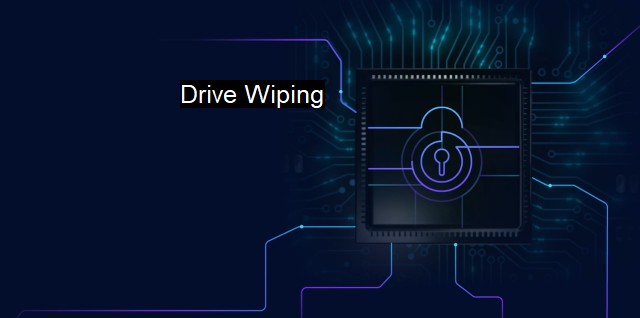What is Drive Wiping?
Drive Wiping: The Ultimate Solution for Safeguarding Confidential Data and Preventing Cyberattacks
Drive wiping is a common term in internet security, closely tied to cybersecurity and antivirus measures. It is a vital concept in ensuring data privacy, resilience, and risk management particularly for organizations dealing with crucial client information and sensitive payloads.Drive wiping refers to the process of completely erasing data from a storage device, such as a hard disc or solid-state drive. As opposed to common delete or format operations, which merely erase pointers to the data or clear the file system tables making it seem like the drive is empty, drive wiping involves overwriting all the physical bits in the storage medium with zeros, ones or random patterns.
It is carried out to ensure data once stored is irretrievable by conventional methods to protect sensitive details falling into the wrong hands. IT experts perform this action, guaranteeing absolute erasure of contents as part of good data privacy practice when disposing of, recycling, or repurposing digital devices.
In terms of cybersecurity, drive wiping is key to strength and integrity. On a corporate level, it helps organizations decrease the vulnerability of sensitive information to potential threats, hacking attempts, and data breaches. It proves inseparable from practices aiming to maintain data integrity and confidentiality, ensuring files are securely erased and preventing unauthorized users from recreating or accessing them.
Drive wiping plays a central role in antivirus defense. Viruses, ransomware, spyware, or any harmful software can lurk deep within hardware systems, more so storage disks. The idea is that by completely erasing the contents of the disk, including OS, system files, and applications, one could effectively eradicate these potentially harmful programs, limiting the opportunity for malware regeneration or spike in server attacks.
For drive wiping to secure a system thoroughly, it’s imperative to follow stringent methodologies. Simple rewriting of zeros may not entirely obliterate data. There exist recovery tools capable of interpreting residual magnetism on disk space and recovering old writes. Thus, the Department of Defense in the United States developed advanced drive wiping standards, recommending specific algorithms with differing overwrite patterns, speeds and insulation strategies to assure complete data sanitization.
Challenges do exist. Data sanitization effectiveness can be severely compromised if cryptographic erase methods are improperly implemented or if the storage media contains bad sectors that obstruct sanitization commands. Likewise, failing to wipe hidden areas on the storage device, like the Host Protected Area (HPA) or Device Configuration Overlay (DCO), may leave retrievable data intact.
References to drive wiping are also abundant in legal statures and compliances worldwide. Laws require operations housing sensitive user data or classified government information to engage proper data destruction methods. Relevant audits may even require documentation proof of the applied erasure process for end-of-life assets.
Drive wiping is integral to cybersecurity and antivirus measures, going much beyond deletion and format. It ensures data is indecipherably wiped off, incapable of being traced back. Given the increasing data threats and regulatory requirements, it is of paramount importance for businesses and individuals alike to have protocol strategies and opt for professional help if necessary in properly executing drive wiping procedures.

Drive Wiping FAQs
What is drive wiping?
Drive wiping is the process of completely erasing all data from a storage device, such as a hard drive or USB flash drive. It's done to prevent unauthorized access to your sensitive information and to reduce the risk of data breaches.Why is drive wiping important for cybersecurity?
Drive wiping is important for cybersecurity because it ensures that sensitive data is completely erased from a storage device, making it much harder for cybercriminals to access it. If a device contains sensitive information and is not properly wiped, it can put individuals and organizations at risk of data theft and cyber attacks.How can I wipe a drive securely?
To wipe a drive securely, you can use specialized software designed for that purpose. Some popular options include DBAN, CCleaner, and KillDisk. Additionally, you should follow the software's instructions carefully and make sure that you overwrite the entire drive with random data multiple times to ensure complete erasure.Is it possible to recover data from a wiped drive?
It's very difficult, if not impossible, to recover data from a properly wiped drive. However, there are specialized data recovery companies that claim to be able to recover data from wiped drives. To prevent this, it's important to use a reputable data wiping software and to overwrite the entire drive with random data multiple times.| | A | | | B | | | C | | | D | | | E | | | F | | | G | | | H | | | I | | | J | | | K | | | L | | | M | |
| | N | | | O | | | P | | | Q | | | R | | | S | | | T | | | U | | | V | | | W | | | X | | | Y | | | Z | |
| | 1 | | | 2 | | | 3 | | | 4 | | | 7 | | | 8 | | |||||||